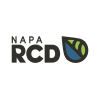What Is a Carbon Farm Plan and Why Does It Matter for Climate Change Mitigation?
Program Spotlight: Carbon Farming Impacts in Napa County
By Miguel Garcia, PhD — Sustainable Agriculture Program Manager
In 2017, Napa RCD created the first Carbon Farm Plan for Vineyards. That’s kind of a big deal! But what on earth does that mean? What is a carbon farm plan?
Let’s take a step back. What’s the carbon cycle?
The carbon cycle is the exchange of carbon among the earth, soils, oceans and waterbodies, the atmosphere, and living things. As part of the carbon cycle, carbon dioxide (CO2) from the atmosphere is captured and stored in agricultural soils in the form of organic matter. This is called carbon sequestration. Carbon sequestration is one method of reducing the amount of carbon dioxide in the atmosphere, which can help mitigate global climate change. Agricultural activities can lead to increases or decreases in soil carbon, and in turn this leads to increases or decreases of CO2 in the atmosphere. For example, practices such as tillage and use of fuel-burning agricultural equipment release CO2 into the atmosphere, while maintaining living roots for extended periods of time and minimizing soil disturbance can decrease CO2 in the atmosphere.
Okay, so what is a Carbon Farm Plan?
The implementation of land management practices that reduce greenhouse gas (GHG) emissions or enhance the ability of soils to sequester carbon is called “Carbon Farming.” A Carbon Farm Plan (CFP) strategizes a farm’s approach to carbon farming.
It helps farmers make decisions about how to invest in practices to get the most climate bang for the buck.
Since organic carbon is at the center of fundamental physical, biological, and chemical mechanisms in the soil, increasing soil carbon through Carbon Farming has the potential to improve soil health, enhance crop production, minimize runoff and erosion, improve soil water-holding capacity, increase infiltration, build climate resiliency, and increase biodiversity.
What does it look like to create a Carbon Farm Plan?
The first step in the carbon farm planning process is to do an inventory of all soil management practices and GHG emission sources on the farm. Next, opportunities to enhance soil carbon sequestration and reduce GHG emissions are identified. The farmer’s goals and economic considerations help prioritize practices from the many opportunities that may exist. The third step is implementation. Napa RCD works with farmers to identify funding sources to pay for the practices and provide technical assistance for implementation. Over time, Napa RCD works with farmers to reevaluate and update the CFP to reflect changing objectives and implementation opportunities.
For Napa RCD, the carbon farm planning process is a year-round effort but most of the work is completed during the vine dormant season in the winter to coincide with farmers’ availability. During this time of the year, Napa RCD is mostly focused on conducting site visits and beginning the writing process for ongoing plans. At the moment, Napa RCD is accepting applications from anyone interested in developing a carbon farm plan. Contact Miguel@NapaRCD.org to get started.
To date, Napa RCD has been able to offer assistance in the development and implementation of carbon farm plans at no cost to farmers, thanks to grants and donations that the organization has secured. Napa RCD continues working to secure future founding that would allow them to continue offering these services at low or no cost.
How has carbon farming impacted Napa County?
Since 2017, Napa RCD has assisted farmers in developing and implementing a total of 52 carbon farm plans.
Combined, these plans cover 3,936 acres and guide farmers towards sequestering about 18,437 metric tons of CO2 every year. This is equivalent to the CO2 produced every year by about 3,900 typical passenger vehicles.
Demand for carbon farm plans has grown tremendously in the past four years, as local farmers are seeing the value that their farms have in being part of the climate solution. An important milestone for carbon farming locally was that Napa Green is now requiring a carbon farm plan as part of its vineyard certification program. Napa RCD is training Napa Green staff to help farmers develop plans, so that more farms can start taking strategic climate action.
